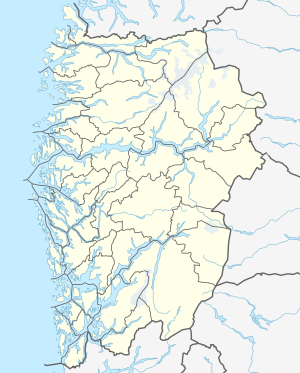Ulrikstunnel
| Ulrik tunnel | ||
|---|---|---|
|
Tunnel from the direction of Arna
|
||
| use | Railway tunnel | |
| traffic connection | Bergensbanen | |
| place | Bergen , Vestland | |
| length | 7,670 m | |
| Number of tubes | 1 (2nd tube under construction) | |
| construction | ||
| start of building | 1959 | |
| completion | 1964 | |
| business | ||
| operator | Jernbaneverket | |
| release | August 1, 1964 | |
| location | ||
|
|
||
| Coordinates | ||
| West portal, Fløen | 60 ° 22 ′ 58 " N , 5 ° 21 ′ 10" E | |
| East portal, Indre Arna | 60 ° 25 ′ 10 " N , 5 ° 27 ′ 46" E | |
The Ulrikstunnel ( Norwegian Ulrikstunnelen ) is a 7,670 meter long railway tunnel in the course of the Norwegian Bergensbane , which crosses under the northern part of the Ulriken in Fylke Vestland . It is located between the Bergen and Arna train stations .
History of the original tunnel
Before the tunnel was completed in 1964, the railway line ran via Nesttun . The opening of the line through the railway tunnel resulted in a route shortening of around 21 kilometers. The first train passed through the tunnel on August 1, 1964. The passage took about seven minutes. The tunnel is one of the longest rail tunnels in Norway and was the longest on the Bergen Railway when it opened.
expansion
The Norwegian Ministry of Transport decided in February 2009 that the railway line between Arna and Bergen should be double-tracked before a road tunnel is built on the same route. In connection with the planning, Jernbaneverket stated that the line between Arna and Bergen is Europe's single-track line with the highest traffic density. In addition to a large number of passenger trains between Oslo and Bergen, 14 freight trains ran daily. With around 120 trains per day, the route is fully utilized.
The double-track expansion between Bergen and Arna is divided into two projects. The first stage is the construction of the second track from Bergen train station to the western end of the tunnel, a distance of 1.3 km. The second stage is the construction of the route between Fløen and Arna, which includes a second, approx. Contains 7,700 meter long tunnel through the Ulriken. It was planned that the double-track expansion between Bergen and Arna would be completed in 2016 if the necessary funds were made available.
Construction of the entire project began in 2013. In March 2015, the blasting work had progressed so far that the 151-tonne tunnel boring machine, which was delivered in August 2015, could be prepared so that the drilling work should start in December 2015 according to the plans.
The actual drilling work did not begin until January 2016 and, as a novelty, included the first-time use of a tunnel boring machine for the construction of a railway tunnel in Norway.
On August 29, 2017, Bane Nor and the contracted companies Strabag and Skanska celebrated the completion of the drilling work.
The next steps up to the planned commissioning in 2020 are the creation of 16 cross-connections between the old and the new tunnel by means of blasting as well as equipping the new tunnel with tracks, overhead lines and safety devices.
Individual evidence
- ↑ Rådgiverkontrakt for Ulriken til Norconsult. banenor.no, July 28, 2010, accessed September 24, 2019 (Norwegian).
- ↑ Jernbaneverket INFORMERER: Dobbeltspor Arna - Bergen. (PDF) Oppstart i Fløen. jernbaneverket.no, September 2013, archived from the original on February 14, 2016 ; Retrieved May 21, 2019 (Norwegian).
- ↑ Jernbaneverket INFORMERER: Dobbeltspor Arna - Bergen. (PDF) Ny tunnelåpning synlig i Arna. jernbaneverket.no, March 2015, archived from the original on February 14, 2016 ; Retrieved May 21, 2019 (Norwegian).
- ↑ Jernbaneverket INFORMERER: Dobbeltspor Arna - Bergen. (PDF) Tunnelboremaskinen tar form. Jernbaneverket.no, September 2015, archived from the original on February 14, 2016 ; Retrieved May 21, 2019 (Norwegian).
- ↑ Kevin Smith: Norway celebrates Ulriken tunnel breakthrough. In: railjournal.com. September 1, 2017, accessed September 24, 2019 .
Web links
- Ulrikentunnelen. In: Bergen byleksikon. Bergen Byarkiv, accessed May 21, 2019 (Norwegian).

